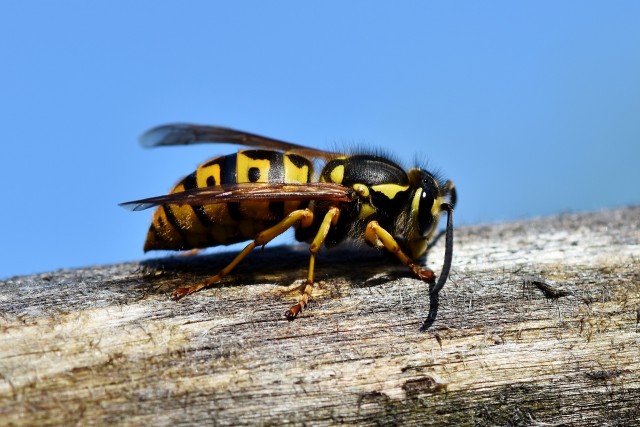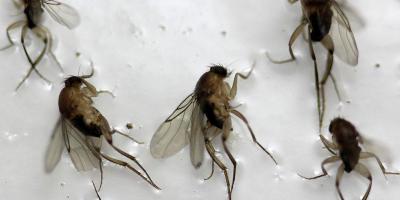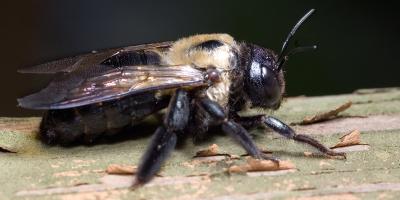Spot The Stinger: How To Distinguish Wasps From Hornets

When the end of August rolls around and everybody is looking to get outside and enjoy the last of the warm weather, it’s easy to forget that flying pests are still out and active. That’s why too many late-summer outings and picnics find themselves inundated with bugs as the summer winds down - and nothing spoils a fun afternoon outdoors quite like a painful sting.
No sting is fun to experience, especially when you don’t see it coming. That’s why it’s always a good idea to know which flying stinger you might be dealing with, and how best to respond to the particular attacker in your area - whether it’s a simple bee, or something a bit bigger like a wasp or a hornet.
The big questions, though: what exactly is the difference between a wasp and a hornet?
Here’s a look at how you can distinguish a wasp or hornet from an average honeybee, and how to tell wasps from hornets and vice-versa. With luck, you should be able to identify - and remove - the particular stinging pest threatening to ruin your end-of-summer outings.
Bees vs. Wasps vs. Hornets
While bees, wasps, and hornets may all share some things in common - wings, stingers, nests, and colors - a closer look shows that all three are actually quite different. Knowing which one you’re actually dealing with can seriously help your removal efforts.
Bees
Of all stinging insect pests to worry about, bees should almost always be at the bottom of the list. Although some bee species do have the potential to sting, many - especially honeybees - can be perfectly harmless, and are often looking for nothing more than a steady supply of pollen and a place to build a nest.
Honeybees - as the name implies - are the only flying insects that produce honey. Generally smaller in size (usually between ½ and ⅝ of an inch), honeybees can be quickly distinguished by bright yellow and black coloring, and are most active in the summer and autumn. While a swarm of honeybees can be frightening, they are generally harmless - and because bees offer huge benefits to natural habitats, these swarms should be safely removed and relocated by a professional when spotted.
Other bee species - like carpenter bees - can be a real nuisance, sometimes boring holes in wood to create nests for their young. Carpenter bees are generally solitary insects, and will not swarm like honey bees. Males also have no stinger, and so cannot sting when threatened. While females are physically able to sting, they rarely will unless roughly handled. Mostly active in spring and summer, carpenter bees can be quickly and safely removed by a stinging insect professional.
Wasps
While easy to mistake for your average bee from a distance, wasps actually come from a different family of insects under the same order, Hymenoptera. Although sharing many similar outward traits as bee, wasps can look, nest, behave, and respond very differently to their surroundings.
Wasps can generally range in size depending on their species, with the common paper wasp (named for its recognizable paper-like nest material, often formed into a football shape) reaching sizes anywhere from 1.9 to 3.2 cm in length, while other wasps species can reach significantly larger sizes.
One major thing that most sets wasps apart from bees is their nesting behavior. Almost all wasp species are solitary insects, with nearly all common species (with a few notable exceptions - more on that later) living as solitary females building nests to raise their own young. Even paper wasps, which do build colonies, are considered semi-social, with nests reaching no more than a small handful of individuals living together.
Another big differentiator between wasps and bees is their diet. While bees are almost exclusively pollinators, many wasp species are actually predators, and will hunt and attack their prey to feed on other insects and even on meat.
Because they are hunters, almost all wasps are able to sting repeatedly - unlike bees, which can generally only sting once. You should take extra care if you suspect a flying pest may be a wasp.
Hornets
Bigger, badder, and more dangerous than any bee, hornets are among the most feared of all flying stinging insects. And although many hornets are significantly larger than most “wasp” species, in reality all hornets are simply types of wasps themselves - only with a few significant differences in size, behavior, and ferocity.
The most common hornets faced by those in North America are actually Yellowjackets, a particular subgroup of wasps distinguished by large bodies (10-16 mm in size), bright yellow coloring, and highly-organized social structures.
Unlike other solitary wasps, yellowjackets tend to amass large nesting groups of up to 1,000 individuals, reaching peak activity in summer and autumn. With diets consisting mainly of meats and sugary carbohydrates, yellowjackets are fearsome hunters that can sting their prey multiple times.
Other species of hornets - including the common Bald Faced Hornet - pack an extra added punch of pain in the form of venom, which can be transmitted through their stinger to cause pain and irritation in their prey. That means a single sting from a hornet can cause pain far and above that of an average wasp or hornet, making them particularly nasty guests to any outdoor gathering.
Ok So… Wasps Vs. Hornets?
While it might be a bit easier to tell wasps and hornets apart from their more docile bee cousins, telling wasps and hornets apart can be a bit more difficult, and usually takes an educated eye to pick out which is which.
Adding to the confusion is the fact that the lines between wasp and hornet are themselves blurry. All hornets, for instance, are wasps, but not all wasps are hornets.
Body Size
For a quick method of telling whether a particular flying stinger is a wasp or a hornet, the first clue should be its size. If the insect is large - say, bigger than a fingernail - there’s a good chance you’re dealing with a hornet. If it’s slightly smaller, with a longer middle section, chances are it may be a wasp.
Nest Behavior
Another major distinguishing characteristic between wasps and hornets is their nesting behavior. Most wasps are solitary, prefering to build their own solitary nest or joining just a few others in building a small colony. If you notice a nest with low activity, the insect in question may be a wasp.
Hornets, however, tend to be highly social, and a single hornet or yellowjacket nest can feature hundreds and even thousands of individuals all working together. A hornet nest will feature the same level of activity as an average bee hive, which can be an immediate clue that the stinger in question is in fact a hornet.
Don’t Let These Stingers Sink Your Summer
Whether you believe your backyard or favorite summer spot is feeling the pressure of hornets or wasps, ignoring this issue is simply not an option for those looking to get out and enjoy the warmth before fall. That’s why it’s always a good idea to have an experienced pest professional on hand who can identify and safely remove these stinging pests before they ruin your next outing.
If you’re worried about wasps or hornets ruining your summer fun, get in touch with JP Pest Services and see what our experienced Wasp & Hornet Removal experts can do to keep your yard free from stinging invaders into winter, spring, and all year long.



